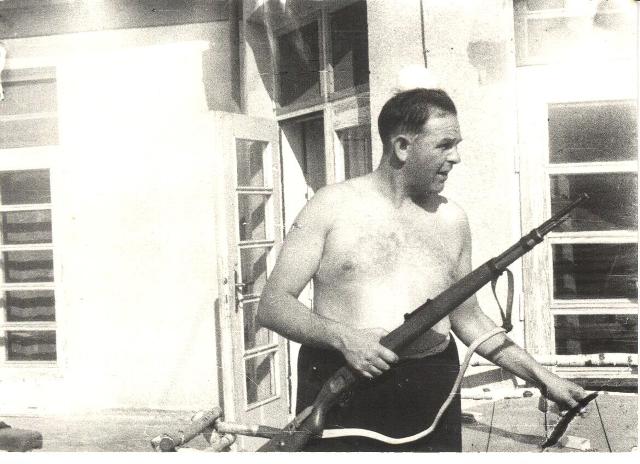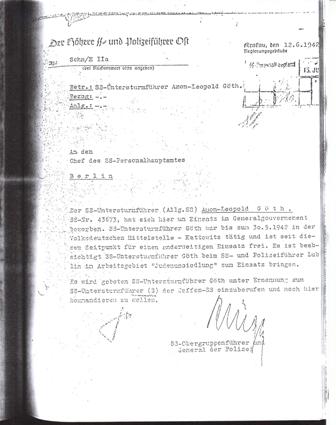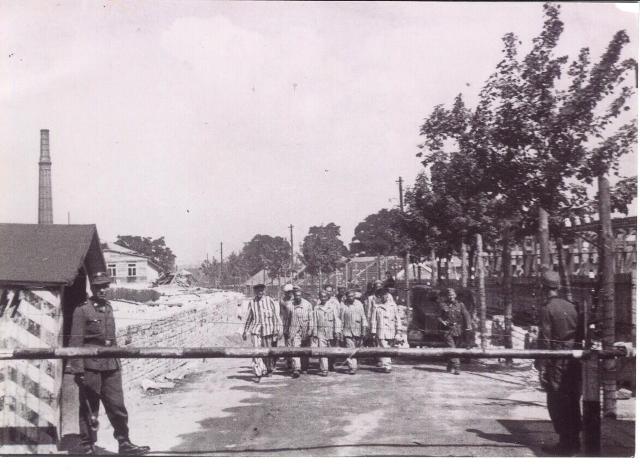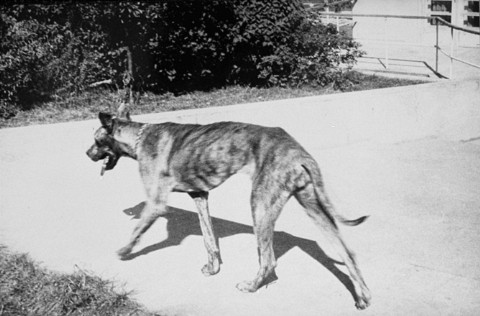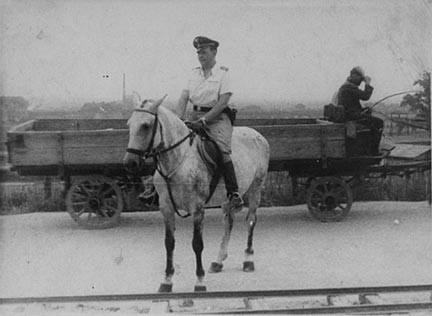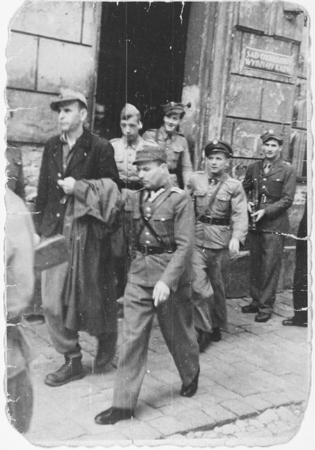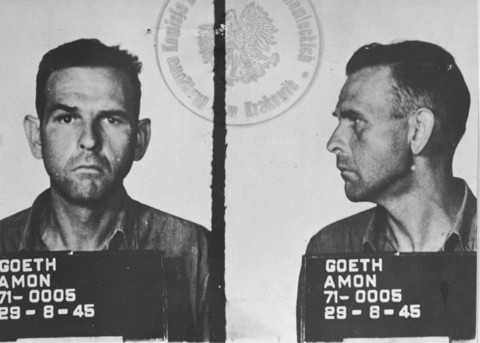Holocaust Education & Archive Research Team |
Ghettos
Krakow Introduction to the Ghettos of the Holocaust
Jewish Ghettos The Judenrat Judenrat Leaders Prominent Jews
|
||||
Amon Göth
Amon Leopold Göth was born on 11 December 1908 in Vienna. He was married twice, divorced in 1934 and again in 1944. He had two children. He studied agriculture in Vienna until 1928, then from 1928 until 1939 he was employed by the company of ‘Verlag fur Militar und Fachliteratur’ in Vienna.
In 1932 Göth joined the NSDAP, his party membership number 510764 and he joined the SS in 1940, his SS number was 43673.
On 5 March 1940 he was drafted into the Wehrmacht, with the rank of Unterfeldwebel. He was promoted in succession to SS-Obersturmfuhrer in 1940 and Untersturmfuhrer with the letter F denoting professional officer in war time, in 1941.
The final rank Göth obtained was SS-Hauptsturmfuhrer in 1944, and he was a holder of the Cross of Merit with swords.
After serving at Cieszyn and the Volksdeutsche Mittlestelle in Kattowice, Göth was transferred to Odilo Globocnick’s staff in Lublin in June 1942, for participation in “Judenumseidlung”. (Jewish Deportations).
In February 1943 he left Lublin after conflict with SS Major Hermann Hofle, Globocnik’s Chief of Staff for Aktion Reinhard, and was transferred to Krakow with the rank of SS-Unterscharfuhrer, as the Commandant of Plaszow Labour camp.
Göth’s service in Krakow was from 11 February 1943 until 13 September 1944. It was clear that Göth had arrived in Krakow with a brief to destroy the remaining Jews of Krakow.
In order to wipe out the Jews of Krakow, the Germans chose a most symbolic site – the new Jewish cemetery on the outskirts of the city, in the suburb of Plaszow. There huts were constructed in desecration of the freshly-dug graves and a sign was hung up ‘Arbeitslager’ (Labour Camp).
Prisoner Joseph Bau (Prisoner Number 69084) described Göth the commandant of Plaszow:
“A hideous and terrible monster who reached the height of more than two meters. He set the fear of death in people, terrified masses and accounted for much chattering of teeth. He ran the camp through extremes of cruelty that are beyond the comprehension of a compassionate mind – employing tortures which dispatched his victims to hell.
For even the slightest infraction of the rules he would rain blow after blow upon the face of the helpless offender, and would observe with satisfaction born of sadism, how the cheek of his victim would swell and turn blue, how the teeth would fall out and the eyes would fill with tears.
Anyone who was being whipped by him was forced to count in a loud voice, each stroke of the whip and if he made a mistake was forced to start counting over again. During interrogations, which were conducted in his office, he would set his dog on the accused, who was strung by his legs from a specially placed hook in the ceiling.
In the event of an escape from the camp, he would order the entire group from which the escapee had come, to form a row, would give the order to count ten and would, personally kill every tenth person.
At one morning parade, in the presence of all the prisoners he shot a Jew, because, as he complained, the man was too tall. Then as the man lay dying he urinated on him.
Once he caught a boy who was sick with diarrhoea and was unable to restrain himself. Göth forced him to eat all the excrement and then shot him."
Another prisoner Gena Turgel recalls, women prisoners were also treated very harshly by Göth:
“My sister Hela was in a group of women sitting, breaking tombstones into tiny pieces for building roads. Another older woman was working with Hela, when Göth appeared and told the older woman she was not doing it right. Göth showed her how to do it. When the older woman returned to her work- Göth shot her”
Göth played a leading role in the destruction of a number of Jewish Ghettos, including the Rzeszow Ghetto in 1942, where the Jews were deported to the death camp at Belzec, the Krakow ghetto on 13 – 14 March 1943, where he personally shot about 50 children and he supervised the liquidation of the Tarnow Ghetto in early September 1943 10,000 Jews were deported to Plaszow, and 4000 were killed.
During the liquidation of the Tarnow Ghetto, he shot a girl who asked him for a transfer to a different working group to be together with her fiancé.
Leon Leser, testified at Göth’s trial:
“There was Ghetto ‘A’ for those working and Ghetto’ B’ for those that were unemployed. Göth ordered everyone employed from Ghetto ‘A’ to go to Ghetto ‘B’ and assemble there in groups, according to their employer.
Every group had a board indicating the name of the employer. Then Göth selected a group of 300 persons as a Sauberungskolonne (clearing up column). The Jews assembled once again separately.
At that point a fiancé of one of the Jewish men approached Göth, her name was Batista, begging him to allow her to stay with her fiancé, who was remaining.
He refused, she begged him once again, he ordered her to turn around and fired into her head. She fell dead and after that he separated all the people again, he took out those that should go to Plaszow, and those that were left behind remained on the Magdeburger Square”.
During the clearance of the Tarnow Ghetto Göth misappropriated Jewish property, furniture, furs, clothing, jewellery, tobacco and alcohol, which were later found by the Gestapo in storage, at Brunnlitz. Also at Brunnlitz was Göth’s mistress Ruth Irene Kalder, also known as ‘Majola’.
Göth also supervised the progressive liquidation of the forced labour camp in Szebnie near Jaslo. The liquidation began on 21 September 1943 with the killing of 700 Jewish prisoners who were driven in lorries to a forest in Tarnowiec, 3km from the camp, where they were shot. This ‘aktion’ was carried out by SS-Hauptscharfuhrer Grzymek and supervised by the commandant Kellermann, acting on orders from Göth.
Göth also prepared under the leadership of Willi Haase, plans for the liquidation of ghettos in Bochnia, Rzeszow and Przemysl.
On 13 September 1944 Göth was arrested by the SS und Polizeigericht Vl (Police Court) in Krakow for large- scale fraud.
Göth was also interrogated by the Sicherheitspolizei (Security Police) for giving information to the engineer Grunberg about the liquidation of the Krakow Ghetto. Grunberg a German was sympathetic to the Jews and closely associated with Stern, Pemper and Schindler. He passed the information on to Schindler, who in turn warned the ghetto leaders.
Göth was released from prison in January 1945, due to his diabetes and was moved to a sanatorium in Bad Tolz. There he was arrested by the Americans.
The Americans agreed to the request to extradite Göth to Poland following a request by the Polish authorities and Göth was tried before the Polish Supreme Court on charges of committing mass murder during the liquidations of the ghettos in Krakow and Tarnow and the camps at Plaszow and Szebnie.
He was sentenced to death in Krakow on 5 September 1946 and hung in the former camp at Plaszow on 13 September 1946, defiantly saluting Hitler.
Sources:
Amon Göth – Unpublished Document by Robin O’Neil
The Camp Men – French MacLean.
Former Camp Plaszow website – www.cekie.krakow.pl/oboz_plaszow
USHMM Holocaust Historical Society
Copyright H.E.A.R.T 2007
|
